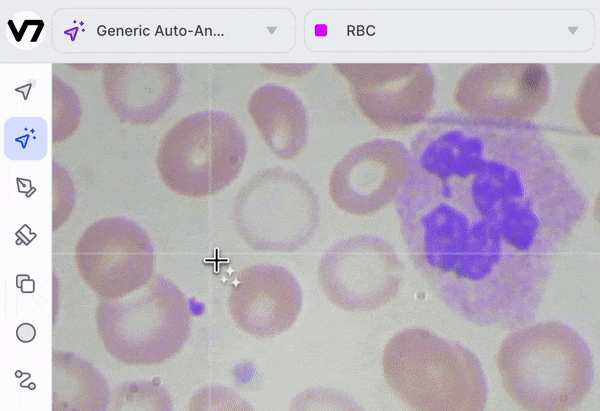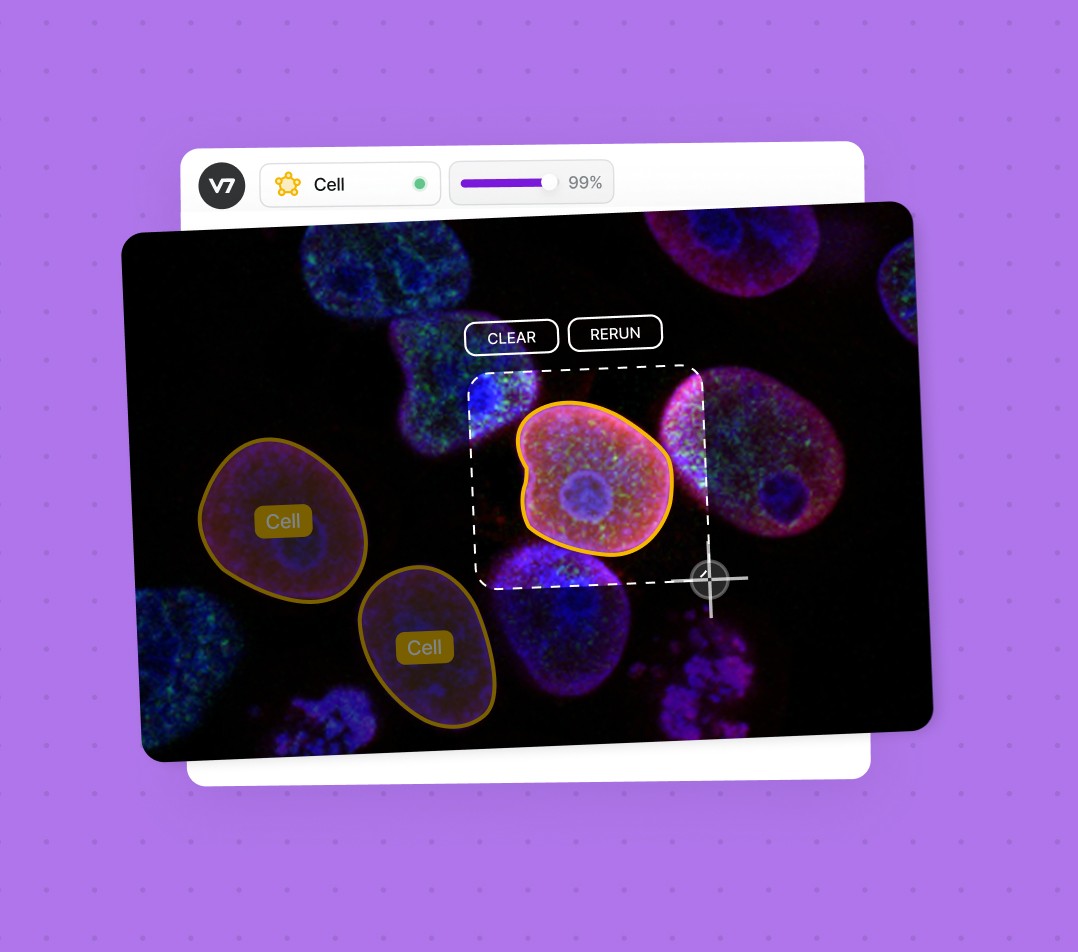AI implementation
AI in Digital Pathology: 4 Transformative Applications
10 min read
—
Apr 6, 2023
What benefits does AI offer digital pathologists? How can it revolutionize the field and what are its biggest challenges? Learn about the state-of-the art of AI in pathology.

Guest Author
Pathology is a sub-field of medical science that aims to research and develop new and efficient drugs and treatment procedures. The advances in machine learning and artificial intelligence affected this field, creating a new division called digital pathology.
Under digital pathology, microscopic images of tissue samples are transferred to a computer, where they are analyzed using advanced image processing techniques and computer vision.
Digitization of medical imagery and diagnosis opens up avenues for artificial intelligence in pathology. Pathologists can use machine learning models to conduct enhanced analysis and improve result accuracy. Moreover, AI in pathology provides second opinions to practitioners, further aiding their day-to-day work.
In this article, we’ll cover the following applications of AI in digital pathology:
Cancer diagnosis and treatment
Pandemic prevention
Pathology training and education
Drug research and development
AI in digital pathology: Overview
With technological advances, digital pathology has gained traction as more labs leverage artificial neural networks for improved analysis.
The Covid-19 global pandemic accelerated AI developments in medical science. According to FortuneBusinessInsights, the market for digital pathology rose 31.2% in 2020 compared to 2019. The global market stood at $735.75 million in 2020 and further grew to $892.5 million in 2022. That is an impressive growth of 21% in just two years. The market is projected to grow to $1791.3 million by 2030 at a CAGR.
A prime example of digital pathology applications is whole slide images (WSI). WSI creates a digital scan of the microscope slide and loads it onto a computer. Users can then apply digital transformations and image enhancement techniques for AI-based analysis.

Many applications for AI in pathology aid clinical analysis by providing faster and more accurate diagnoses. Let's take a look at some use cases involving clinical-grade computational pathology.
Pro tip: Looking for tips on annotating digital pathology images better? We have you covered.
Improved cancer diagnosis and treatment
Developing efficient cancer treatment has been a challenge for medical practitioners for a long time. Although conventional biopsy results are highly accurate, finalizing the results requires a significant amount of time.
Artificial intelligence systems can gather, and process required information within minutes and produce cancer outcomes with an accurate diagnosis. Researchers and pathologists have developed several AI models that demonstrate the capabilities of machine learning algorithms for cancer and tumor detection.
Learn more: AI in Radiology: Pros & Cons, Applications, and 4 Examples
Computational Pathology Group (CPG), a research group from the Department of Pathology at Radboud University Medical Center, has developed and deployed several medical image analysis applications. Their recent project combines digitized whole-slide prostate cancer images with deep learning techniques. The project aims to detect novel quantitative biomarkers to prevent unnecessary surgeries.
Another of CPG's publications demonstrates the use of existing datasets to predict new targets. They obtained state-of-the-art performance on colon and head-and-neck cancer metastasis tasks using high-quality datasets and networks from metastatic breast cancer patients.
Many international biotechnology firms use artificial intelligence to enhance digital pathology procedures. Genmab, a biotech firm, develops antibody therapeutics for fighting cancer. They use data science and artificial intelligence to gain insights from histopathology slides regarding targets, investigational products, indications and patient biomarkers. Genmab has opted for V7's image annotation tool for labeling over 5000 medical images for tumor detection. It helped the team to create training data more efficiently and fine-tune their deep learning models.
Pro tip: Learn more about how Genmab uses V7 to speed up tumor detection in digital pathology images
The breakthroughs of artificial intelligence in digital pathology have attracted entrepreneurs and investors from around the globe. Several start-ups have started working on developing AI systems for aiding cancer detection.
X-Zell uses single-cell imaging fused with artificial intelligence to identify cancers in their early stages. They have collaborated with the Singapore General Hospital (SGH) and the National University Hospital Singapore (NUH) to explore how single-cell imaging can help detect prostate cancer in whole blood. The pilot study has suggested a 70% reduction in unnecessary biopsies when using X-Zells' diagnostic tools.
Fighting and preventing pandemic
The COVID-19 pandemic prompted researchers to start building AI systems that would help prevent, counter, and contain such outbreaks in the future.
Medical research organizations and companies have started leveraging artificial intelligence in a clinical setting to diagnose new diseases. For example, vaccination research has been sped up with the help of digital and computational pathology and machine learning models.
A Korean company, JLK Inspection, has integrated the reverse transcription-polymerase chain reaction (RT-PCR) and imaging tests into their AI-based universal healthcare platform, AIHub. This new addition helps detect the COVID-19 virus and expands the vast library of medical solutions, including prostate cancer, breast cancer, hemorrhagic stroke, and brain aneurysm detection.
Persivia, a patient care artificial intelligence service provider, integrated COVID detection functionality into their Soliton AI engine. The module uses machine learning for real-time EHR and demographics data analysis. The application offers diagnostic accuracy on multiple levels, with level 1 being issued for possible recent travel history and level 4 when the diagnosis is confirmed.
Moreover, Artificial intelligence can be vital in forecasting global pandemic outbreaks. EPIWATCH, an artificial intelligence-based monitoring system, uses global information to detect signs of an outbreak. The system consists of two AI sub-modules, the first of which uses NLP and ArcGIS location data to track the geographic location and create a disease report. The second classifies the report and the situation into four urgency levels and notifies users of the threat level.
Read more: 7 Life-Saving AI Use Cases in Healthcare
Pathology training and education
The use of artificial intelligence in clinical practice aid pathologists in many ways. Techniques like digital image analysis and machine learning are excellent in predicting cancer outcomes. These AI models can help with pathological diagnosis and train pathologists to identify areas of interest in tissue samples.
AI-assisted learning parallels conventional education, with AI algorithms providing additional but valuable insights. Other than accurate diagnoses, artificial intelligence also suggests personalized medicine based on patient demographics and history. Working with AI-assisted methodologies, pathologists learn niche details regarding tissue analysis. AI models can distinguish the slightest anomaly in medical scans. Such minor anomalies might go undetected by humans; however, deep learning algorithms identify them, providing practitioners with a possible learning opportunity.
Faster drug development
Drug development is a complex process consisting of years of research, clinical trials, and approvals.
AI in digital pathology can speed up the process. AI models have access to genomic data, health records, and molecular data and can understand information more deeply. For example, researchers at the University of Sheffield and AstraZeneca have developed an AI model, DrugBAN, that predicts whether a drug will engage with its partner protein molecules in the intended manner. This approach could reduce the drug discovery process from years to months.
PathAI, a BioPharma Services organization, uses AI for next-generation diagnostic pathology. They host a database of 15 Million annotations created by 450 pathologists. By partnering with medical giants like GlaxoSmithKline, PathAI aims to speed up drug discovery and development with their AI-powered platform.
Moreover, drug discovery has a significant cost associated with it as well. Funding clinical laboratories, researchers, and equipment for years requires large capital. A research study found that the average per-drug development cost ranged from $161 Million to $4.54 Billion in the U.S.
Artificial intelligence techniques can significantly reduce these costs by narrowing the experimentation and improving the success rate. A Morgan-Stanley report suggests AI can reduce costs by 20% to 40% for preclinical development across U.S. laboratories.
Pro tip: Learn how V7 can aid your biotech & life science project
Challenges and limitations of AI in pathology
Artificial intelligence in medical applications is always faced with a series of difficulties. The challenges range from the quality of input data and model performance to ethical problems. Some key challenges include:
Poor quality data
Major applications of AI include using digital pathology slides with image analysis algorithms for accurate diagnosis. However, preparing slide images is a cumbersome process involving embedding, cutting, staining, and scanning the tissue sample. Due to this, only a few datasets are available for adequate training.
Moreover, the image preparation process is so complex that the slide samples can become distorted. Elements such as dust, hair, and air bubbles can easily make their way into the slides undetected. This results in poor-quality data and weakly supervised deep-learning models. A weak model presents unreliable results and raises questions about its integrity.
Data dimensionality and hardware limitations
Whole slide imaging deals with data in the size of giga-pixels. A typical slide scan spans around 100,000 by 100,000 pixels in size.
Deep learning algorithms, on the other hand, are often trained using images of around 250 by 250 pixels. This is because the computer hardware used for training cannot store such large-sized files.
As a workaround, images are downscaled before being passed to the model. The images lose vital information during downsampling, resulting in performance degradation.
Pro tip: Check out our guide on how to spot AI bias in training data
Lack of clinical and technical expertise
Building an AI model requires experts in clinical-grade computational pathology, statistics, artificial intelligence, and on-field medical professionals. The process consists of the collection and preparation of clinical data, annotation, model training, and, finally, validation.
Each of these experts plays a vital role in the entire process. Medical practitioners guide researchers regarding data analysis. For example, a radiologist can best describe mammography of breast or lung cancer patients. Their guidance helps collect data and annotate the most complex cases. Statisticians contribute valuable insights from the data, while AI engineers build robust and scalable models. Finally, pathologists and practitioners validate the model's outcome, ensuring accuracy and fairness.
However, gathering so many experts is a challenging task. Not only is it time-consuming, but it also adds to the project's cost and complicates the development process.
Pro tip: V7 provides on-demand labeling services and can help you quickly assemble a scalable team of professional annotators.
Lack of transparency
Despite their success in numerous fields, deep learning algorithms are often "black box models”—little information is provided on how the results are achieved.
Transparency and accountability are absolutely crucial for medical experts. Practitioners must provide proper reasoning and justifications for why a certain decision was made. Since AI models do not provide clear reasoning, building trust with their outcomes is difficult.
Final thoughts
Digital pathology has significantly impacted medicine and healthcare. Researchers have been developing new methodologies to combat new and existing diseases, adapting techniques like machine learning for improved results and smoother workflows.
The adoption of AI has been mostly well-received throughout the medical research community. Pathologists have started leveraging artificial intelligence for efficiency and improved daily work results. AI models aid scientific research by offering valuable insights and producing excellent diagnostic accuracies from whole slide image analysis.
Moreover, artificial intelligence brings several benefits to pathology, including enhanced cancer diagnosis, offering second opinions for general analysis, training practitioners, and speeding up drug discovery and development.
Computer vision is just one type of AI in Healthcare, we're also seeing more and more uses of AI document automation tools in this space.
AI developments in pathology are no short of a revolution in improving healthcare. However, they are not free of challenges. Problems such as a lack of quality data and medical experts for successful training and validation hinder the development of production-grade models. Moreover, the black-box nature of AI raises questions about the model's integrity and creates a trust deficit amongst many users.
Despite the challenges, researchers continue exploring new possibilities and achieving new breakthroughs. The future of AI in digital pathology is looking bright, and V7 is proud of helping to shape it.
More articles on artificial intelligence across different industries:












